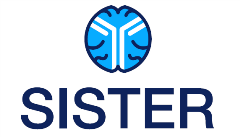
SISTER (Strategy for Improving Stroke Treatment Response)
STUDY OVERVIEW:
SISTER is a phase-2, prospective, randomized, placebo-controlled, blinded, dose finding trial that aims to determine the safety and preliminary efficacy of TS23.
TS23 is a monoclonal antibody against the alpha-2 antiplasmin (α2-AP), in acute ischemic stroke.
The study will be conducted at up to 50 U.S. sites and enroll a total of 300 adults (>18 years) with acute ischemic stroke who have a baseline NIHSS >6 and are able to receive study drug within 4.5-24 hours after stroke onset (or last known well) who have evidence of core-penumbra mismatch on baseline perfusion imaging and are not planned for endovascular intervention or standard of care intravenous (IV) thrombolysis.
Trial Design & Outcomes
The study will have four intervention arms of TS23 with doses of 3 mg/kg, 5 mg/kg, 7 mg/kg and 10 mg/kg compared to placebo.
TS23/placebo will be administered in one dose intravenously over approximately 15 minutes.
The subjects will be monitored, in-hospital, for 3 days or discharge, whichever is first. They will have study visits at 30 days and 90 days post study drug administration.
The subjects will have PK specimens obtained prior to study drug administration, 3 hours, 30 hours and 90 days post study drug administration. Anti-drug antibodies will be obtained prior to study drug administration and at 90-day follow-up. Research related fibrinogen levels will also be drawn, processed and resulted locally.
The study will be monitoring for the following safety outcomes:
- Incidence of symptomatic ICH within 30 hours of study drug administration
- Incidence of non-ICH major or clinically relevant non-major bleeding withing 30 days of study drug administration
- Non-bleeding, serious adverse events within 90 days of study drug administration
- Incidence of stroke-related and all-cause deaths within 90 days
- Plasma fibrinogen levels at 3 hours after completion of study drug administration
Objectives, Endpoints & Analysis
Objectives
To identify a dose of TS23 that is safe and more efficacious than placebo for the treatment of patients from 4.5 – 24 hours of ischemic stroke onset, or last know well, who have evidence of core-penumbra mismatch on perfusion imaging and are not a candidate for standard of care reperfusion therapies.
Primary Endpoints
- Safety:Any intracranial hemorrhage (ICH) visualized on the CT scan at 30 hours (+/- 6) after study drug administration.
- Efficacy:NIHSS score at 30 hours (+/- 6) after study drug administration (adjusted for the baseline in analysis)
Secondary Endpoints
1. Biomarker Efficacy
Analysis
This study is a Phase IIa, Bayesian, adaptive, dose-finding trial. This study was designed and all simulations were performed using the Fixed and Adaptive Clinical Trial Simulator FACTS™ v6.4 Core Design software developed by Berry Consultants.
The Primary Analysis will be Bayesian. We will test whether the best dose of TS23 has at least 25% Utility (Promising Zone). The trial is a success if the best dose has utility of 0.25 or higher with at least 80% probability. Such a utility can be achieved through various combinations of 24-hour NIHSS improvement and ICH rate.
Study Sponsor, Lead Investigator, Other Collaborators
Sponsors:
- The National Institute of Neurological Disorders and Stroke (NINDS)
- Translational Sciences, Inc.
Lead Investigator
Eva Mistry MBBS, MSCI – The University of Cincinnati, College of Medicine Department of Neurology
Other Collaborators
- PI Team – can be included individually for research team
- Eva Mistry MBBS, MSCI
- Pooja Khatri MD, MSc
- Guy Reed MD, MS
- Jordan Elm PhD
- Project Managers
- NIH StrokeNet National Data Management Center at Medical University of South Carolina
- NIH StrokeNet National Coordinating Center at the University of Cincinnati
- University of Cincinnati Imaging Management Center
- University of Arizona
- University of California, San Francisco